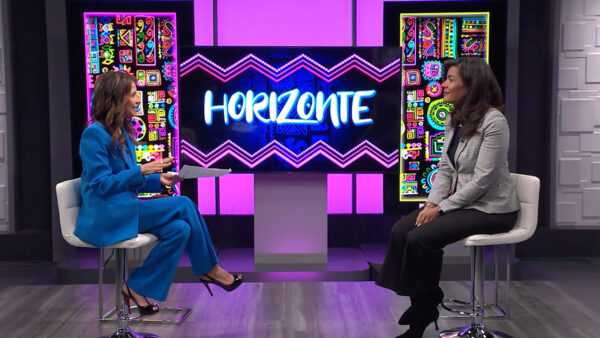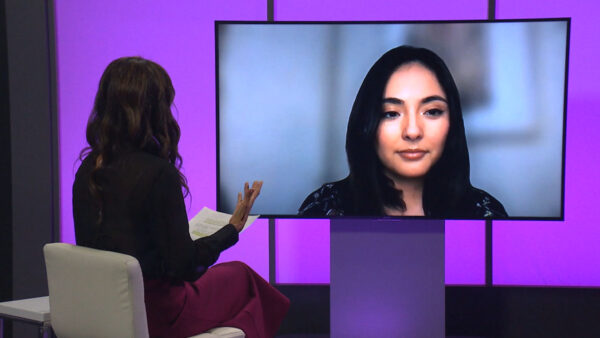The ASU Art Museum presents a new commissioned work by Mexico City-based artist Yoshua Okón. Oracle is a multi-channel video installation that centers on anti-immigration protests In Arizona against unaccompanied children who are fleeing violence and poverty in Central America. ASU Art Museum Director Gordon Knox talks about the exhibition.
JOSE CARDENAS: Good evening. I'm José Cárdenas. We'll tell you where you can see an exhibition centering on anti-immigration protests against refugee children. And we'll discuss the trade and economic relationship between Arizona and Mexico. Plus, learn about a group of health experts hoping to improve public health conditions in the U.S.-Mexico border region. All this coming up on "Horizonte."
Funding for "Horizonte" is possible by contributions by the Friends of Eight, members of your Arizona PBS station.
JOSE CARDENAS: Thank you for joining us. The ASU Art Museum is presenting thought provoking by Mexico City base artist Yoshua Okon. Oracle is a multichannel video installation centering on anti-immigration protests in Arizona, against unaccompanied children who are fleeing poverty and violence in Central America. Joining me to talk about this Gordon Knox, ASU Art Museum director. Welcome to "Horizonte."
GORDON KNOX: Thank you so much.
JOSE CARDENAS: Part of this is a reflection of a direction that the Herberger Institute is taking in terms of community involvement and so forth. Tell us about that.
GORDON KNOX: You know the Herberger Institute is really recognizing the role of the arts and design is key to the advancement of society and culture generally. The role of the arts in terms of being able to prepare society for the types of transformations ahead of it, it's essential. Science and technology will help a great deal, but the arts in the end will solve the problems. And Herberger is systemically engaging with the community. So that's very much what we're doing at the museum, as well.
JOSE CARDENAS: The problem that's being addressed is a huge one for Arizona, which is often referred to as ground zero for immigration debate. But one of the benefits of this approach is; it's based on an artist in residency program.
GORDON KNOX: It is. The key element to this particular project is the fact that we have a residency program. We are able to bring artists into the community, let them sit here, stay, work, get to know the community and then develop new projects that directly relate to the issues that are most paramount to Arizonans today. And in this case, Yoshua Okon came in to work on the tensions at the border between immigrant children, coming up from Guatemala and Central America and the Arizonans living on the border regions, particularly in this case in Oracle, Arizona, and their response to this influx of young immigrants.
JOSE CARDENAS: Which was a huge issue in the news just a few months ago. But before we get into the details of the exhibition. Okon give us a little bit of his background.
GORDON KNOX: He's a Mexico City born and raised, Los Angeles, UCLA trained, he went there for his masters in fine arts. And he has his work -- he's really an engaged artist because he's involved in the arts community in Mexico City in a very real way. He started a program in a space and it is a workshop for young artists from Mexico to have access to interesting thinkers from around the world. So it invites artists from L.A., New York, London to come and be in residence and work with young artists in Mexico City. His work is also connecting across the world because his work is at the Hammer, his work is in the Whitney in New York City, and, of course, in our collection now with our commission.
JOSE CARDENAS: And this particular exhibition on display until the 22nd of August, where exactly?
GORDON KNOX: The main building of the ASU Art Museum, which is Tempe on mill avenue and 10th street. There's free parking, free admission.
JOSE CARDENAS: Let's talk about the exhibition itself. It's described as a multichannel video. What does that mean? What would people see when they go to the exhibition?
GORDON KNOX: Multichannel video installation is exactly what it says. There's a number of different video channels. In this case it's four, so it's a four channel video installation. It's a large gallery, our top gallery, one of the largest we have in the building and in it we have four different video projections. There's two adjacent to each other and then one-on-one wall and one on another. So you're sort of in an environment of video experience and the screens themselves are choreographed to have a complete presentation. You may get all of the screens showing the same image or you may get some screens showing another and then a complementary image, and they bleed in and out and not all of them are at the same time always, sometimes they are. So it's a full immersive environment, nice place to sit down. It's about a 18-minute sequence for the entire loop and you get a chance to really enter into the thinking as well as the experience of both the kids coming up, the nature of the cause of this migration from the highly troubled central American countries that were so devastated by American intervention in the '70s and '80s. You have also the local Oracle community.
JOSE CARDENAS: The people protesting.
GORDON KNOX: The people protesting and they're protesting not against particularly a group of people but they're protesting against a breakdown of a way of life. They see themselves as protecting a form of living, a national image of what life is like in America.
JOSE CARDENAS: As I understand it, if you go and you watch it from the beginning, the first thing you see is some video on the children and we've got one still picture of that that we're going to put up on the screen right now. Tell us what this symbolizes and this is from a video so there will be some activity.
GORDON KNOX: This is a shot of the young chorus of Guatemalan refugees who have come into the U.S. This is actually shot in Mexico on the Mexican side of the border. They are waiting there.
JOSE CARDENAS: And that's where they were deported to.
GORDON KNOX: That's where they were deported to and they're sort of in a holding situation but what they've done is they've created a little chorus as part of their activities and in this case they're singing a song about the transformation that took place in Guatemala with the united food company and the various American interventions in the establishment of sympathetic regimes in Guatemala and how that situation and its deterioration has made it necessary for them to flee their country, which is very dangerous at this point, which is why as they keep saying in the scene why we are here.
JOSE CARDENAS: And the next sets of images that you would see would be the protesters themselves, and I think these are minute men and this is a reenactment, is that right? We've got a picture of them that we want to put up on the screen. The original protest as I understand was the largest to date at that time, and this is a reenactment?
GORDON KNOX: This is a reenactment. These are some of the core members of the larger protest. These are an active group who are very interested in as I say preserving an ideal way of life for them in the town of Oracle and in the border region of Arizona. It's also fair to say that I was quite pleased to see that Yoshua was able to engage in conversation with them whereby it became clear they're concerned about a way of life more than they're concerned or against any particular group of people.
JOSE CARDENAS: And then the last kind of segment of this presentation is a fascinating one, involving the leader of the group and Yoshua joining him in his pickup and we've got a picture of him doing circles in the desert.
GORDON KNOX: Yes. This is an amazing piece of footage. Again, projects like this can only happen by engaging with the community. This is not something Yoshua dreamed up and tried to create. Instead, it was brought to him by the leader of the group who said Yoshua, I want you to sit with me in my truck and I want to talk with you about some of the deeper philosophies I have about what we do. And the environment he wanted to have this conversation in was the cab of his pick-up truck as it was going around in circles and he was occasionally shooting either his pistol or his machine gun out the window. So you have a setting that you could not possibly imagine but it was really one generated by the members of the group in Oracle, by the leader in particular, and it gives him an opportunity to talk about his love for this country and how he's hoping to protect it.
JOSE CARDENAS: And he's saying all this while he's driving in circles, shooting out guns out the window?
GORDON KNOX: I have to say I saw it and I was suddenly scared for poor Yoshua because he was driving and pulling guns out -- but everything worked out well. Yes, he was doing it all at once.
JOSE CARDENAS: One last area I want to cover real quickly is this is the second part of the series that Yoshua began before called Octopus. That's coming to ASU, as well.
GORDON KNOX: That's coming to ASU. It will open on the 24th of August and it will be on display until the 2nd of October, and it's at our downtown residency project space and that's on McKinley and 3rd street in the combine building.
JOSE CARDENAS: Through the beginning of October. Last question, what's it about?
GORDON KNOX: It's a brilliant opportunity for Joshua to work with immigrants from Guatemala who were soldiers in the rebel army fighting against the state in Guatemala and who are now looking for work outside of a Home Depot in Los Angeles. Yoshua had them reenact some of their wartime experiences while people are walking past them to go in and out of Home Depot. It's a fascinating exercise in contrast.
JOSE CARDENAS: It certainly sounds like it. Gordon Knox, thanks for joining us to talk about it, fascinating artist and fascinating exhibit.
GORDON KNOX: Thank you so much, it's a pleasure to be here.
JOSE CARDENAS: Thank you.
Gordon Knox:ASU Art Museum Director























